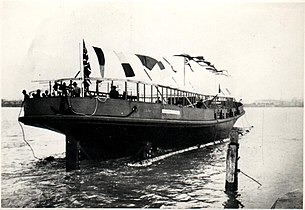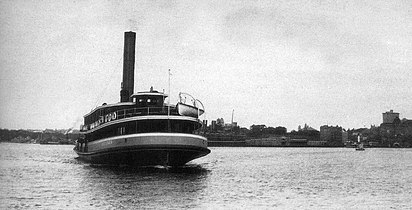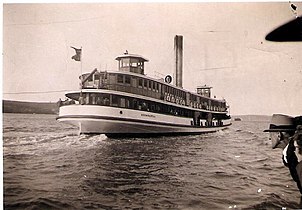HMAS Koompartoo
 Koompartoo undergoing her sea trials, 1922
| |
| History | |
|---|---|
| Name | Koompartoo |
| Namesake | Aboriginal word meaning new beginnings |
| Owner | Sydney Ferries Limited |
| Route | Circular Quay-Milsons Point |
| Builder | Walsh Island Dockyard and Engineering Works, Newcastle |
| Yard number | 53 |
| In service | 1922 - 1941 |
| Name | HMAS Koompartoo |
| Owner | Royal Australian Navy |
| Acquired | 18 June 1942 |
| Commissioned | 23 December 1942 |
| Decommissioned | 8 June 1962 |
| Identification | Z256 |
| General characteristics | |
| Tonnage | 448 GRT, 201 NRT |
| Length | 191 ft (58 m) |
| Beam | 38.3 ft (11.7 m) |
| Speed | 12 knots |
| Capacity | 2,089 |
| Armament | |
HMAS Koompartoo was a Sydney Ferries Limited K-class ferry later converted to an Royal Australian Navy boom defence vessel.
Koompartoo and her sister ferry, Kuttabul, commenced ferry service in 1922. The highest capacity ferries to ever run on Sydney Harbour, they were designed and built for the short heavy-lift run on the Circular Quay to Milsons Point across to Sydney's North Shore prior to the 1932 opening of the Sydney Harbour Bridge.
Following the opening of the Sydney Harbour Bridge, both ferries were redundant. During World War II, they were requisitioned by the Royal Australian Navy. Kuttabul was sunk during the 1942 Japanese Attack on Sydney Harbour with the loss of 19 lives. Koompartoo was converted to a boom defence vessel and taken to Darwin. Following the War, she was laid up in Sydney until 1962 when she was taken to Launceston, Tasmania where her hull was used as bauxite barge. Her final fate is unclear.
The name, "Koompartoo", is thought to be an Australian Aboriginal word meaning "fresh start", and the boat followed about twenty previous Sydney Ferries K-class vessels named with Aboriginal words starting with "K".
Background[]
In the early twentieth century, prior to the opening of the Sydney Harbour Bridge in 1932, Sydney Ferries Limited was running one of the largest ferry fleets in the world to cater for booming demand for ferry services across Sydney Harbour to Sydney's North Shore. In particular, more and bigger ferries were needed to service the crowded Milsons Point to Circular Quay route (in the approximate location and route of the current Sydney Harbour Bridge). The Milson's Point wharf was an interchange with the North Shore rail terminus and is now the location of Luna Park. Peak hour ferries were leaving either side of the harbour at the rate of one fully loaded vessel every six minutes. An order was placed for two similar and very large steel-hulled high capacity ferries - Koompartoo and Kuttabul - to service the short heavy-lift route.
Design and construction[]
The two ferries were built in 1922 by the Walsh Island Dockyard and Engineering Works in Newcastle.[1] At 58 m (190 ft) in length, and with very large beams of 11.7 m (38 ft), the two vessels were the largest ferries owned by Sydney Ferries and the last of the company's K-class. The two boats represented the peak of the K-class design of double-ended ferries. Rated to 2,089 people, they had the highest passenger capacity of any ferries ever on Sydney Harbour, and could carry almost 500 people more than even the larger Manly ferries.
Koompartoo's 113 hp triple-expansion steam engine, built by the builder, pushed her to 12 knots. The two sister ferries were built with steel hulls and wooden superstructures unlike most other K-class ferries, which were built with timber hulls (sisters Kanangra and Kirawa, both 1912, also had steel hulls). Koompartoo was constructed with 18 watertight compartments, regarded as being unsinkable and therefore was not required to carry life saving equipment.[2][3] Koompartoo's livery generally followed the Sydney Ferries Limited tradition of varnished superstructures with white edging around the promenade deck. The steel hull and main deck bulwarks were painted a light grey. Her strikingly tall single funnel was painted black.

Sydney Ferry Koompartoo being launched, 1922

Koompartoo on the Circular Quay to Milson's Point route for which she was designed and built. Prior to Sydney Harbour Bridge opening, likely 1920s.

Koompartoo thought to be photographed new at Walsh Island Dockyard, 1922
Ferry service[]
For ten years, Koompartoo and Kuttabul ran the short heavy lift trip between Circular Quay and Milsons Point. Supporting the large steel hulled twins, were usually the timber "K-class" Kuramia (1914), Kaikai, and Kulgoa.[4] In 1926, Koompartoo collided with Kaikai.[5]
With the opening of the Sydney Harbour Bridge in 1932, the once crowded route was effectively redundant. Koompartoo and Kuttabul were too big to be useful on the other cross harbour routes which also saw significant and sudden drops in trade, and the two ferries were laid up. Almost twenty Sydney Ferries were decommissioned in the two years following the bridge's opening. The two were both of relatively young age and were considered for conversion to run the Manly route.[6] Koompartoo was later made available for tourist, spectator and concert cruises on the harbour.[7] Her wheel houses were raised (flying bridges) in the 1930s to allow her master to see over spectators on the decks. Her roles included service carrying crowds of passengers to the regular Head of the River rowing carnivals and following the sailing boat races that were growing in popularity at the time. This was also the period of the Great Depression and Koompartoo found a new career as a concert boat, a role she filled between 1935 and 1941.

Koompartoo post-1932 opening of bridge. Possibly in use as an excursion ferry

Koompartoo approaching Milsons Point wharf showing her notably wide beam.

Koompartoo with flying bridges and after conversion to concert ferry (mid to late 1930s)
World War II[]

In 1941, Koompartoo was purchased by the British Ministry of War Transport for service in the Middle East and taken to Mort's Dock for conversion. However with the outbreak of the Pacific War she was never deployed, instead being taken over by the Royal Australian Navy on 18 June 1942 and converted to a boom defence vessel. Armed with two 20mm Oerlikons and four Vickers .303 MGs, she was commissioned on 23 December 1942 under the command of Lieutenant GG Moss, RANR (S) and taken to Darwin in January 1943 where she served until the end of the war.. Held in reserve in Darwin from 1945 until 1950, she returned to Sydney and was laid up at Athol Bight.[8]
In April 1962, she was declared for disposal and sold out of the Service on 8 June 1962, stripped of her superstructure and towed to Launceston in 1966 for use as a bauxite barge.[9][10] Her final fate is unclear, however, it is thought she may have sunk in Port Latta and then removed.[11][12]
See also[]
- List of Sydney Harbour ferries
- Timeline of Sydney Harbour ferries
- Sydney K-class ferries
References[]
- ^ Prescott, Anthony (1984). Sydney Ferry Fleets. Ronald H Parsons. ISBN 0909418306.
- ^ The Koompartoo Sydney Morning Herald 13 April 1922
- ^ "The Kuttabul. New Ferry Steamer.". Sydney Morning Herald. August 1922. Retrieved 1 May 2012.
- ^ Andrews, Graeme (1994). Ferries of Sydney (Third ed.). Sydney: Oxford University Press / Sydney University Press. pp. 87–89. ISBN 0-424-00202-7.
- ^ "FERRY SMASHES HAVE BEEN FREQUENT". Evening News. No. 18835. New South Wales, Australia. 4 November 1927. p. 15. Retrieved 27 March 2021 – via National Library of Australia.
- ^ Andrews (1975), p. 103
- ^ SS Koompartoo Ferries of Sydney
- ^ Gillett, Ross (February–April 1977). "Sydney's Fighting Ferries". The Navy, the Magazine of the Navy League of Australia. 39: 29–32. Retrieved 5 January 2019.
- ^ navy.gov.au
- ^ Andrews (1975), p. 89
- ^ facebook.com
- ^ flickr.com
External links[]
 Media related to Koompartoo (ship, 1922) at Wikimedia Commons
Media related to Koompartoo (ship, 1922) at Wikimedia Commons
- Boom defence vessels of the Royal Australian Navy
- Ferries of New South Wales
- Ferry transport in Sydney
- Iron and steel steamships of Australia
- Ships built in New South Wales
- 1922 ships
- Sydney K-class ferries






